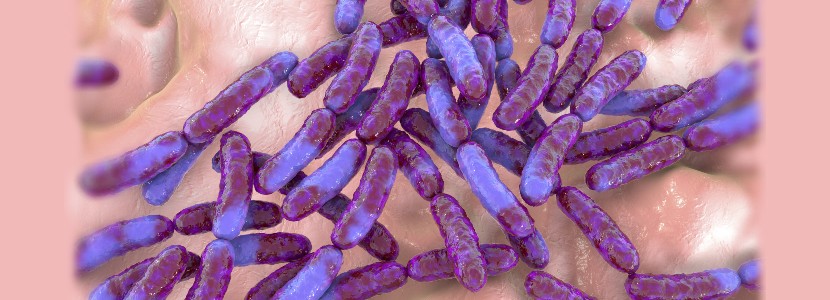 23 Jun 2022
23 Jun 2022
Microbiota-host interactions can be influenced through dietary strategies. This presents a novel tool with potential health and productive benefits for animals.
The intestinal tract of monogastrics and ruminants has great influence on animal health preservation and disease. Therefore, optimal intestinal health is essential in animal performance.
This entry aims to complement our previous publication on how the modulation of microbial composition and its metabolites can contribute to increasing animal resilience and health.

Microbiota: Signal production capacities
The composition of gut microbiota varies with age and in relation to the the different gastrointestinal segments(Stanley et al., 2014; Song et al., 2017; Sun et al., 2019; Yang et al., 2019). There is a general consensus regarding the fact that microbiota diversity increases with age. Very often under industrial animal production conditions, the first stages (birth or hatching) tend to be as sterile as possible. This scenario is considered unfavorable and young animals are prone to pathogen colonization due to a a delay in the establishment of a protective microbiota.
The microbiota composition varies between the different segments of the gut. In general low numbers of bacteria are found in the proximal segments of the gut while numbers increase towards the distal ileum, caecum or colon. The rumen of cattle is an exception, as this part is the main fermentation chamber for this species. Diversity usually increases significantly towards the distal gut, presenting a limited variability in the small intestine where lactobacilli are oftenly dominant. While the distal intestinal tract harbors a large number of different bacterial groups. The distal intestinal tract of healthy individuals tends to be dominated by bacteria from the phyla Bacteroidetes and Firmicutes which together comprise more than 80% of the total microbiota. The phylum Bacteroidetes contains multiple polysaccharide degrading bacterial species, while Firmicutes contains a variety of bacterial families, including Ruminococcaceae and Lachnospiraceae families, which are considered as important health-promoting populations thanks to their butyrate production. Some members of the phylum Proteobacteria are also present, but in lower numbers, including Enterobacteriaceae such as Escherichia Coli. Therefore, Gram-negative bacteria amongst which there are opportunistic pathogens tend to be associated with harmful inflammatory effects.
The number of microbial genes in the gut, the microbiome, exceeds the number of animal genes, and together they form a ‘hologenome’ (Rosenberg and Zilber-Rosenberg, 2011).
The bacterial community has the genetic potential to carry out an enormous number of physiological functions. The variety of bacterial functions includes degradation of complex substrates (polysaccharides, proteins, fat), fermentation of substrates to yield acidic compounds, immunomodulation, communication with other bacteria, and many more. The metabolites produced by the bacterial community are of vital importance for maintaining gut health and controlling pathogen colonization.

Polysaccharide breakdown
Polysaccharide breakdown is performed by the microbiota in a cascade in which different bacterial members take care of specific catalytic steps in degrading the substrates (Flint et al., 2012). Complex substrates (such as polysaccharides, including arabinoxylans, pectins, and cellulose) are converted to oligosaccharides by specific bacterial populations (e.g. lactobacilli, some Bacteroides species, and others), and these oligosaccharides are then used by other bacterial groups to produce short-chain fatty acids (i.e acetic, propionic and butyric acid), lactate and gases. Some polysaccharides can be broken down into glucose by single species. Depending on the bacterial strains that carry out these conversions, other end products can be produced.
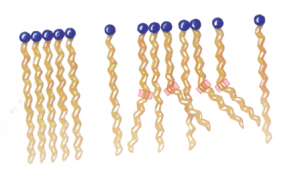
Short-chain fatty acids
They are the best known final products derived from polysaccharide fermentation. Apart from commonly known acids: acetic, propionic and butyric acid, succinate and lactate can also be produced. The most important butyric acid producing bacteria belong to the Ruminococcaceae and Lachnospiraceae families (Pryde et al., 2002). Butyric acid has a variety of beneficial properties, including pathogen control, anti-inflammatory effects, increased mucin and antimicrobial peptide production, strengthening of the epithelial barrier, etc. (Guilloteau et al., 2010).
The effects of specific metabolites (i.e. polyamines spermidine, cadaverine, but also indoles) on host cells are not always clear, but some of these seem to have effects on transepithelial resistance as well. If an unfavorable shift in microbiota composition occurs (dysbiosis) certain crucial steps for specific pathways may be deficient, causing changes in bacterial metabolites within the gut. There is a complex interaction between different bacterial populations for specific substrates, and the outcome of this competition can drive the microbiota to one that produces beneficial metabolites that promote gut health or toxic metabolites.
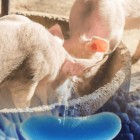
Influencing bacterial signaling and host responses though nutritional intervention
A variety of feed additives are used nowadays as either antimicrobial growth promoter alternatives or gut health stabilizers. Some of these have the capacity to inhibit certain bacterial groups, yet for the most part they are intended for modifying the microbiota towards a more favorable composition.Resulting in significant beneficial effects for the host, either directly or indirectly through the microbiota. As it was previously stated, feed formulas and feed additives should: improve intestinal epithelial integrity, stimulate tolerance responses towards non-harmful bacteria, prevent excess inflammation, stimulate host antibacterial responses (mucin and antimicrobial peptide production) and help to establish a state of mutualism between the host and its gut microbiota. Therefore, feed additives and feed formulas should favor beneficial microorganisms while inhibiting pathogen colonization.
Prebiotics, probiotics, synbiotics and short chain fatty acids. Potential tools for modulating the composition of microbiota and its metabolites
Probiotics
Probiotics are defined as live microorganisms that, when consumed in adequate amounts, confer a health effect on the host. The most widely used bacterial probiotics are Bacilli, as they are stable in formulation (spores) and produce antibacterial compounds, apart from beneficial metabolites that are under discovery. As an example, it was recently discovered that specific Bacillus species produce high concentrations of niacin in vivo. Niacin is sensed by special receptors which activate anti-inflammatory responses (Singh et al., 2014). Niacin has been shown to reduce epithelial apoptosis in the rumen of cattle induced by excess butyrate (Luo et al., 2019). Apart from Bacillus species, also other single strain probiotics are marketed, including lactobacilli. There multiple reports within scientific literature on the effects of probiotics on animal performance, protection against pathogens and much more.
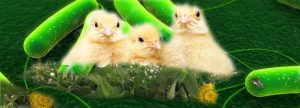
However, there are many studies on probiotics which remain unpublished due to inconsistent results or negative effects. It is important to identify the mechanisms of action of probiotic species which do have consistent health effects, in order to evaluate their metabolites and how can they exert direct or indirect effects on host health. In this way new dietary additives can be developed based on reproducible beneficial results, instead of empirically developing and marketing probiotics.
Prebiotics
Prebiotics are defined as natural or processed functional foods which contain biologically active compounds that have documented health benefits by modifying the interactions between beneficial and pathogenic bacteria (Gibson and Roberfroid, 1995).
Most prebiotics are oligosaccharides, such as fructooligosaccharides (FOS), galactooligosaccharides (GOS), arabinoxylan oligosaccharides (AXOS), xylan oligosaccharides (XOS) and raffinose family oligosaccharides (RFOs). Prebiotics are complex molecules due to factors like: chain length, the nature of the sugar bounds, and the nature of the side chains on the saccharides. All of these, have the capacity to alter specific functions. Various published studies focus on the beneficial effects of prebiotics on broiler performance and pathogen control.
However, as with probiotics, it is difficult to draw conclusions from potentially biased data in many of these scientific papers. Considering the fact that many of these publications only report beneficial effects and positive results. Therefore it is necessary to strive towards science-driven developments where the mechanism of action plays a central role for the development of prebiotics.

Synbiotics
Synbiotics are combinations of pre- and probiotics and thus offer the bacteria directly the substrate they can convert to beneficial metabolites (Roberfroid, 1998). However, there is still a lot of research to be done before these synbiotics can be developed with a high success rate. As it is necessary to have a clear understanding regarding the nature of the substrates required to stimulate beneficial bacterial groups.
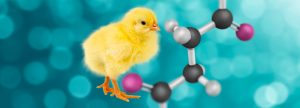
Short chain fatty (and other) acids
Drinking water and feed additives containing SCFAs, medium chain fatty acids and even aromatic acids are widely used in the animal production industry. While drinking water acidification is mainly for sanitation purposes, feed additives are used mainly for optimizing animal performance and for pathogen control (Van Immerseel et al., 2006).
Conclusions
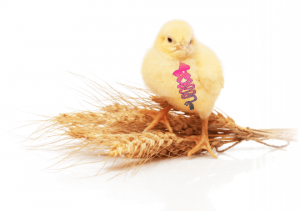
Abstract modified from: Proceedings of the Animal Nutrition Conference of Canada 2020. Author/s: Filip Van Immerseel / Department of Pathology, Bacteriology and Avian Diseases Faculty of Veterinary Medicine, Ghent University, Belgium.
Subscribe now to the technical magazine of animal nutrition
AUTHORS

Nutritional Interventions to Improve Fertility in Male Broiler Breeders
Edgar Oviedo
The Use of Organic Acids in Poultry: A Natural Path to Health and Productivity
M. Naeem
Synergistic Benefits of Prebiotics and Probiotics in Poultry, Swine, and Cattle
Gustavo Adolfo Quintana-Ospina
Hybrid Rye Potential in Laying Hen Feed Rations
Gwendolyn Jones
A day in the life of phosphorus in pigs: Part I
Rafael Duran Giménez-Rico
Use of enzymes in diets for ruminants
Braulio de la Calle Campos
Minerals and Hoof Health in the Pregnant Sow
Juan Gabriel Espino
Impact of Oxidized Fats on Swine Reproduction and Offspring
Maria Alejandra Perez Alvarado